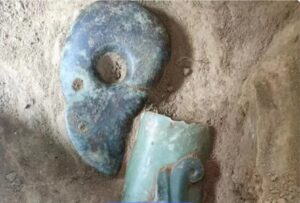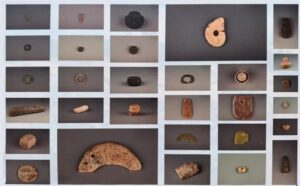(Article on the Excavation of Yuanboshan Hongshan Culture Site)
On September 22, at 9:48 a.m., the Inner Mongolia Institute of Cultural Relics and Archaeology announced the discovery of a new stone tomb site at Yuanboshan, 1.5 kilometers north of Balqi Village, Hawa Township, Aohan Banner, Chifeng City, Inner Mongolia, during a symposium commemorating the 70th anniversary of the naming of the ‘Hongshan Culture.’ A jade dragon, measuring 15.8 cm in length, 9.5 cm in width, and 3 cm in thickness, was unearthed, which is the largest jade dragon in the 100-year history of Hongshan culture archaeological research.
This site is the first discovered in Inner Mongolia that combines a rectangular altar to the south and a circular tomb to the north, serving both burial and ritual functions. The outer diameter of the northern circular stone tomb measures 23.5 meters, and the diameter of the later stone mound reaches a maximum of 28 meters. This archaeological excavation uncovered more than 100 pieces of jade from the Hongshan culture, including three jade pig-dragons of varying sizes. To date, 21 tombs, three stone mounds, and one sacrificial pit have been excavated across a total area of 1,400 square meters, yielding more than 200 artifacts, including pottery, stone tools, jade, bone artifacts, and shell artifacts.
The 100 pieces of jade from the Hongshan culture unearthed include most of the known types of Hongshan jade artifacts. They provide essential material for a deeper understanding of the social structure, organizational management, interpersonal relations, and the formation of jade rituals in the late Hongshan culture. Moreover, these findings hold significant value for studying the ritual culture of the Hongshan state, its cultural identity, and the origins of Chinese ritual culture.
(Evaluation)
This is a notable excavation after a long period of time. However, most of the Hongshan jade artifacts unearthed here are not of the most iconic forms. Notably absent are the solar deity and the C-shaped dragon, and there are very few animal-shaped carvings. As is typical in the later stages of the culture, the variety of artifacts has significantly decreased. The unearthed jade dragon does not seem to be the largest. For comparison, the collection in the Bairin Right Banner Museum measures 16.8 cm in height, 11.5 cm in width, and 2.8 cm in thickness, while the collection in the Liaoning Provincial Museum measures 15.8 cm in height, 11.5 cm in width, and 4.3 cm in thickness
.
https://baijiahao.baidu.com/s?id=1810876402771560709&wfr=spider&for=pc

